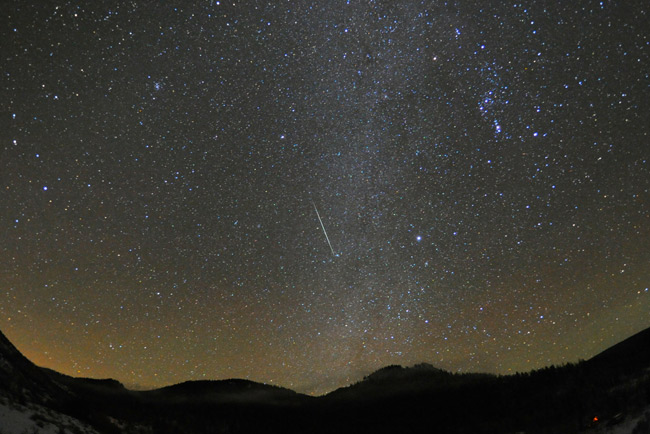
If your skies are clear early tomorrow (June 11) morning, it might be worth your while to step outside and look for shooting stars.
For a short time, maybe an hour (quite possibly less than that), stargazers might be treated to a brief flurry of meteor activity — or nothing at all. The uncertainty surrounding tomorrow's meteor shower is part of a mystery that goes back more than 80 years.
On the evening of June 11, 1930 three members of the American Meteor Society (AMS) reported a bevy of meteor activity occurring between the hours of 10:15 and 10:45 p.m. local time in Maryland. [See Incredible Night Sky Photos from Stargazers (June 2013)]
What made this observation particularly unusual was that the moon was very nearly full and shining brightly in the southeast sky. Usually a bright moon hides all but the brightest stars, and it certainly was not the kind of night anyone expected to see very many meteors. And yet, for half an hour, three reputable meteor observers were seeing meteors — in spite of the bright moonlight.
Nobody else reported seeing any meteors that night, and in the years that followed, those who kept a careful watch on the sky on the night of June 11 saw no noteworthy meteor activity either, leading some to doubt of the authenticity of the 1930 outburst.
But tomorrow morning, for a short while, you'll be able to verify the meteor activity yourself.
Could it happen again?
Get the Space.com Newsletter
Breaking space news, the latest updates on rocket launches, skywatching events and more!
It is not out of the question that many hundreds or even thousands of years ago, a comet swept through the inner solar system, leaving behind trails of dusty debris. This supposed comet's orbit presumably intersects our orbit on June 11. Most years when Earth reaches this intersection point there is nothing for our planet to interact with. But in 1930, we may have passed through a narrow trail of dust leftover from that hypothetical comet — hence the brief flurry of meteors. Tomorrow morning, it may happen again.
Peter Jenniskens of NASA, in his study of outbursts from long-period comets, has proposed that the 1930 event was real and may be repeated tomorrow morning.
The meteors are called "Delphinids" because the radiant or emanation point of these shooting stars come from near the constellation Delphinus, the dolphin, a very tiny, lozenge-shaped group of faint stars; but the stars are so close together that they are easily seen on clear dark nights.
Delphinus is not far away from the yellow-white star, Altair, one of the brightest stars in the sky. For observers in mid-northern latitudes Delphinus rises in the eastern sky shortly after the end of dusk and is best placed high in the southern sky between 4 and 5 a.m. local daylight time.
Report your meteor sightings
The expected time of the meteor outburst is 4:28 a.m. EDT (0828 GMT), 3:28 a.m. CDT, 2:28 a.m. MDT, and 1:28 a.m. PDT. This timing is favorable for all the Americas, extending west to the Hawaiian Islands.
If you live in the Eastern Time Zone, you should start watching around 3:30 a.m. and continue on up until the predicted peak at 4:28 a.m. Thereafter the sky will be getting much too bright thanks to the dawn twilight and approaching sunrise.
"No one knows the strength of this display or whether it will occur at all," Robert Lunsford of the AMS said. "It would most likely be of short duration (less than one hour and perhaps as short as 15 minutes). This is not something one can stand outside and try to witness. Serious observers should be comfortable in a lounge chair and watch for at least an hour. I would not expect strong rates such that occurred with the Leonid outbursts that occurred back in the years 2001-2002. Rather these meteors are more likely to appear a minute or two apart. Unlike the 1930 display, the moon will not be a factor in 2013 as it will have set long before the predicted time of the outburst."
Lunsford and the AMS would like to hear from anyone who attempts to view these meteors. He notes: "Even reports with no activity will help. Be sure to share your observations (either positive or negative) with us as soon as possible after viewing." Reports may be emailed directly to him at: lunro.imo.usa@cox.net
Editor's note: If you snap an amazing picture of the possible meteor outburst or any other night-sky view that you'd like to share for a possible story or image gallery send photos, comments and your name and location to Managing Editor Tariq Malik at spacephotos@space.com.
Joe Rao serves as an instructor and guest lecturer at New York's Hayden Planetarium. He writes about astronomy for "Natural History" magazine, the "Farmer's Almanac" and other publications, and he is also an on-camera meteorologist for News 12 Westchester, New York. Follow us on Twitter, Facebookand Google+. Original article on SPACE.com.
Join our Space Forums to keep talking space on the latest missions, night sky and more! And if you have a news tip, correction or comment, let us know at: community@space.com.

Joe Rao is Space.com's skywatching columnist, as well as a veteran meteorologist and eclipse chaser who also serves as an instructor and guest lecturer at New York's Hayden Planetarium. He writes about astronomy for Natural History magazine, Sky & Telescope and other publications. Joe is an 8-time Emmy-nominated meteorologist who served the Putnam Valley region of New York for over 21 years. You can find him on Twitter and YouTube tracking lunar and solar eclipses, meteor showers and more. To find out Joe's latest project, visit him on Twitter.









